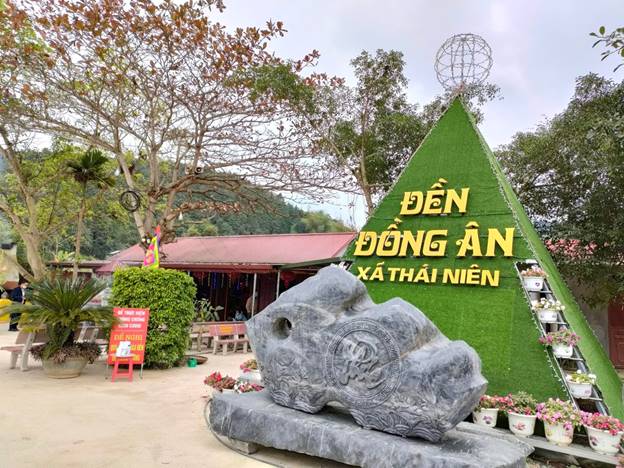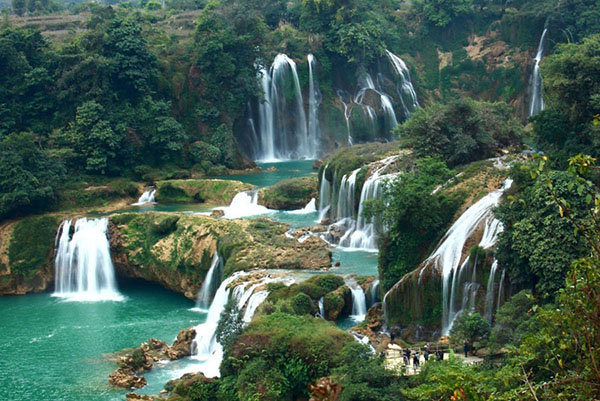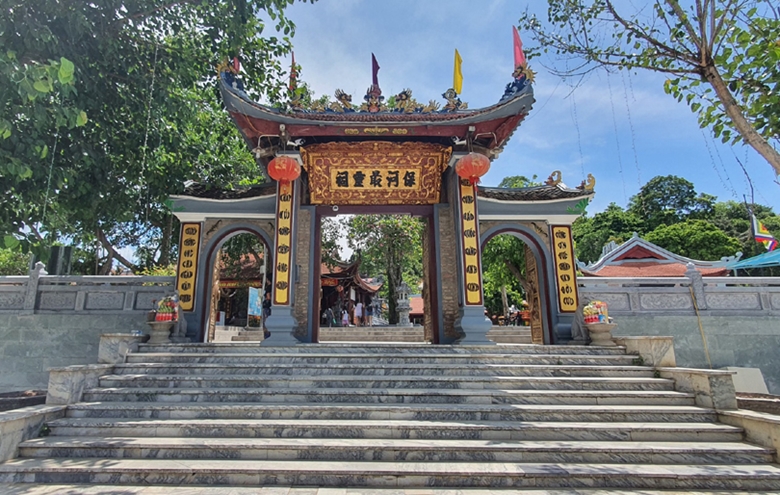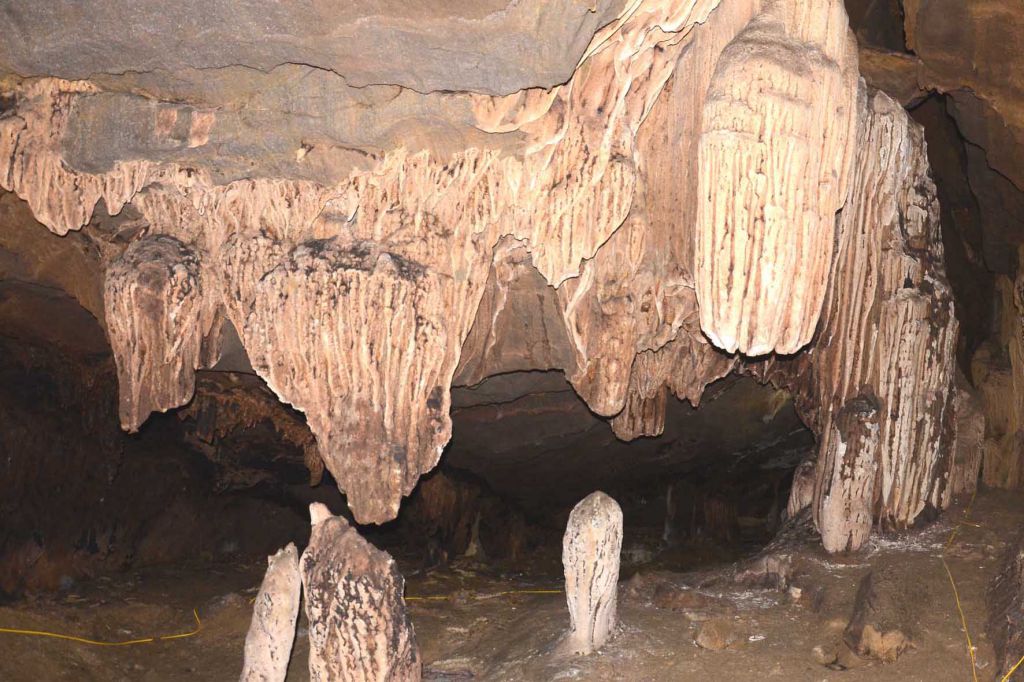Relic point Vietnam
Việt NamDong An Temple
Dong An Temple is a relic with a long history. Up to now, the foundation of the ancient temple still remains, showing that this place was once built on a very large scale, including bricks from the Le Dynasty (late 18th century) and a A number of artifacts dating back over 100 years are kept at the temple. Dong An is an ancient name with the meaning that the people are united in their gratitude to the general Hung Dao Dai Vuong - Tran Quoc Tuan, who had merit in the war to expel the Yuan-Mongol invaders. In addition, the temple is also known by local people by another name, Mi temple, because it was previously associated with the name of Mi village. Experiencing ups and downs of historical fluctuations associated with the heroic land of Bao Thang over the centuries, the Temple is still located on a field in Quyet Tam village, Thai Nien commune, Bao Thang district. With a strategic location along the Red River, belonging to the ancient Bao Thang gate, the temple is both a spiritual cultural milestone marking the territorial sovereignty of the border region and one of the places of secret revolutionary activities of the Vietnamese government. Bao Thang's army and people during the resistance war against the French colonialists. Dong An Temple is the place to worship Saint Tran, Hung Dao king Tran Quoc Tuan. During the three resistance wars against the Yuan and Mongols, he used his strategic skills to lead soldiers and people everywhere to unanimously defend the country. Among them, it is impossible to mention the land of Quy Hoa (present-day Lao Cai), where Bao Thang gate is located at the beginning of the Fatherland, which is one of the key points that the Northern enemy targets every time they invade our country. Therefore, during the resistance war against the Northern invaders, Bao Thang was always a key position for our army on the strategic map. During the three resistance wars against the Mongol army, under the talented leadership of Tran Hung Dao, the army and people of Quy Hoa region actively defended the gate, blocking the enemy right from the border gate, contributing to the victory. of the people of the whole country. To commemorate the merits of the generals and soldiers who joined the people in fighting against foreign invaders and the talented leadership of Hung Dao King Tran Quoc Tuan, people everywhere came together to build temples to express their deep gratitude. . In Lao Cai city, there is Thuong Temple, a temple dedicated to him, built in the 17th century, built by local people for worship, and annually welcoming many domestic and foreign tourists to celebrate and sightsee. Although the exact age of Dong An temple has not been determined, based on the results of archaeological excavations of Dong An temple's foundation, the earliest construction materials for the temple date back to the Le dynasty (18th century). Therefore, it can be said that Dong An Temple is a temple that, although it exists after Thuong Temple, is also one of the relics worshiping Hung Dao King Tran Quoc Tuan and has many spiritual meanings for Bao Thang people for many generations. . To this day, people still say, "This land used to be a vast field with luxuriant vegetation along the Red River. That year, the Northern invaders invaded, and Tran Dynasty generals went up to suppress the border invaders." During the battle, he was injured and then when he returned to the temple grounds, he stopped to recuperate. After that, the people saw only the armor left but no body, so they built a temple to commemorate that general's merit in fighting the enemy." With historical values, in 2016 Dong An Temple was recognized by the Provincial People's Committee as a provincial-level historical and cultural relic. Dong An Temple has a convenient location, located right near the banks of the Red River, overlooking the river with a charming landscape. In the future, it will develop into a spiritual tourist destination that attracts many tourists when coming to Lao Cai in general and Bao Thang district in particular. In the coming time, Dong An Temple will be a bright spot on the spiritual tourism map of Lao Cai province when connected with other relics in the district such as Lien Hoa Pagoda in Phong Nien commune, Ngoi Bo temple in Gia commune. Phu are all relics located along the Red River. Along with the system of sacred temples of Lao Cai province located along the left bank of the Red River such as Thuong Temple, Mau Temple, Cam Temple, Quan Temple, Doi Co Temple... These are attractive spiritual tourism addresses. Tens of thousands of visitors visit, worship, and perform ceremonies on various occasions throughout the year. There are many famous relics throughout the region and region. Besides, with the revolutionary tradition of a heroic district, Bao Thang also has many tourist attractions introducing local history during the resistance periods that contributed to the overall victory of the whole country such as the base area. Soi Co - Soi Gia revolution; Pho Lu station, followed by the famous beautiful Tien cave in Xuan Quang commune, Dau Nhuan waterfall in Phu Nhuan commune with many beautiful, wild and untouched waterfalls. It is an interesting destination for those who like to experience, explore… When connecting Dong An Temple with the above relics and scenic spots, it will form tourist spots and routes that attract tourists to Bao Thang district, creating a new direction in developing the local tourism economy. region in particular and Lao Cai province in general. SOURCE: LAO CAI PROVINCE DEPARTMENT OF TOURISM
Lao Cai 2716 view
Memorial site of President Ho Chi Minh
Located right in the center of Lao Cai city, the memorial site of President Ho Chi Minh in Lao Cai is often known as "Ho Chi Minh Park", located in Lao Cai ward, Laos city. Cai, Lao Cai province. The relic site is a memorial site, marking the only visit of Uncle Ho and the government delegation to the Party Committee and people of Lao Cai. The relic's location is located on the foundation of the old Lao Cai Power Plant, where Uncle Ho spent time visiting and encouraging workers at the power plant construction project that was about to be completed. In the midst of the country's difficulties, despite being busy with thousands of jobs, President Ho Chi Minh took the time to visit and work with the Party Committee and people of Lao Cai on September 23-24, 1958. Remembering the great contributions of President Ho Chi Minh and appreciating his precious feelings for his homeland Lao Cai, on the occasion of the 40th anniversary of Uncle Ho's visit to Lao Cai (1958-1998), Lao Provincial People's Committee Cai built Uncle Ho's memorial area. In 2022, the Memorial Site of President Ho Chi Minh in Lao Cai was recognized by the Ministry of Culture as a national historical relic. This is a spiritual work for people and tourists from near and far to have the opportunity to express their gratitude, respect, and offer incense to commemorate the great President Ho Chi Minh. Besides, the Memorial Area is also a "red address" to educate young generations today and tomorrow about the nation's history, his background, and his great career. This place is always open to welcome people from all over the country to visit and pay their respects and gratitude to President Ho. SOURCE: LAO CAI PROVINCE DEPARTMENT OF TOURISM
Lao Cai 2714 view
Bac Ha station
Bac Ha Fort is located right in the center of Bac Ha town, built on a high hill overlooking the entire Bac Ha town area. This is a large-scale military garrison, built in a spiral shape from low to high, with a barbed wire fence on the outside, followed by a protective wall surrounding the station with many huts. guarding the entrance. Inside the station there are many architectural units with different functions, forming a closed internal system to serve the French army when occupying Bac Ha. Before Bac Ha was liberated, the French colonialists burned Bac Ha station and fled, leaving this historical relic no longer intact. Currently, most of the works belonging to Bac Ha Fort have been destroyed, only a part of them remains such as: blockhouse, three-compartment water tank in the center of the hilltop; a tunnel in the south of the monument and a foundation embankment system surrounding the Fort. Of these buildings, only the walls, roof and foundation systems remain. Some buildings only have traces of their foundations left, such as: Quan Ba's house, horse stables, and soldier's house. Today, being classified as a provincial historical relic, Bac Ha post promises to create an attraction for tourists to visit and learn about the history of our ancestors fighting against foreign invaders in the past. Visit Bac Ha White Plateau. SOURCE: LAO CAI PROVINCE DEPARTMENT OF TOURISM
Lao Cai 2380 view
Silver Falls
Lao Cai province has just ranked Silver Falls, residential group 2, O Quy Ho ward, Sa Pa town, Lao Cai province as a provincial-level scenic relic. The Provincial People's Committee has just issued document No. 3415/QD-People's Committee dated December 31, 2023, ranking Bac Waterfall as a provincial-level scenic relic Accordingly, the relic protection area is determined according to the Minutes of zoning of relic protection areas and the Zoning Map of relic protection areas in the relic scientific records. The People's Committee of Lao Cai province assigned the Department of Culture and Sports and the People's Committee of Sapa town to develop a plan to protect, manage, restore and use the Thac Bac scenic relic in accordance with current regulations. state action. Silver Waterfall scenic spot in Residential Group No. 2, O Quy Ho Ward, Sa Pa Town is one of the attractive tourist destinations, attracting a large number of domestic and foreign tourists (each year welcoming over 45,000 visitors). ). The Silver Waterfall landscape has been known since the 20th century, during the French colonial period, along with famous tourist and resort destinations: Silver Waterfall, Cau May, and Stone Cave. By 2011, Lao Cai province invested in building Thac Bac irrigation lake to store water upstream and adjust to ensure year-round water volume and create majestic landscape and beauty for the waterfall. From a distance, Silver Waterfall looks like a soft, silvery white silk strip across the sky. When approaching, the rushing waterfall looks like a Bach Dragon rising and roaring between the sky and earth in a very majestic way. Having gone through the ups and downs of history and climate change, Silver Waterfall is still a beautiful and attractive place for domestic and foreign tourists, fully meeting the criteria and approved by the People's Committee. Lao Cai province is ranked as a provincial-level scenic relic./. SOURCE: Lao Cai Provincial People's Committee
Lao Cai 2587 view
Ta Phin Cave
National relic - scenic spot Ta Phin Cave is located in Ta Phin commune, Sa Pa district, Lao Cai province, 12km north of Sapa town, this is where two ethnic groups Dao and Mong live. It is also a place with many research and archaeological values, and attracts many tourists to visit. Coming to Sapa, tourists who want to visit Ta Phin Cave will go through town to Ta Phin village, nearly 1km north of the People's Committee headquarters of Ta Phin commune, there is a limestone mountain range, a branch of the mountain range. Hoang Lien Son mountain. In this mountain range there is a small mountain. At the foot of the mountain, visitors see a crack with a cave entrance, about 5m high, about 3m wide, opening a path through the ground, attracting the curiosity of visitors. Tourists come here to explore caves. Starting the journey of discovery underground, visitors go about 30 meters in the dark and bumpy and will encounter a cave. From here, the cave divides into many underground paths that can only fit one person. In many steep sections, one must cling to rocks and swing up and down. Following these small walls leads to more and more paths, there are even corners that turn around and crackle and eventually return to the original position. To continue the journey to explore the cave, visitors follow the path of the big cliff. Here, visitors have the feeling of going up the cliff. The path is zigzag, sometimes up and down, sometimes bulging and sometimes resembling a person. A young woman is holding a baby, some look like bathing fairies, some look like giant raspberries with rough white patches of lava, patches of coral clinging around the edges, some look like smooth white pillars hanging down. from the top down... In particular, the widest part of the cave is on the high dome about 8m, creating conditions for the stalactites to hang down, intertwine with each other without any arrangement, winding, undulating, glittering jade color, with drops of water from the top of the mountain gradually seeping and then condensing. The tip of the stalactite drips like a beat in an illusory space. SOURCE: Lao Cai Provincial People's Committee
Lao Cai 2644 view
Nghi Lang ancient citadel
Nghi Lang ancient citadel Nghi Lang ancient citadel, also known as Phuc Khanh temple, is located in Pho Rang valley, Bao Yen district, Lao Cai, and was recognized as a national historical and cultural relic in 2002. Nghi Lang ancient citadel is a sacred place of worship. The Bau Lords, bearing traces of heroic deeds, fought against the Mac Dynasty, protected the borders of the Bau Lords, protected the people, and protected the country. The Bau Lord Worshiping Festival takes place on the 10th day of the first lunar month every year. People gather to commemorate the Bau Lords' merit in protecting the country. SOURCE: Vietnam Tourism
Lao Cai 1627 view
Bao Ha Temple
Bao Ha Temple When talking about Bao Yen district, no one knows about Bao Ha temple, one of the most popular tourist attractions in this district. Bao Ha Temple worships the national defense god Hoang Bay, a mountain hero who fought the enemy to protect the village. Bao Ha Temple is very majestic, quiet, and the natural landscape here is charming: on the wharf, under the boat, and surrounded by vast, vast, green mountains and forests. Bao Ha's main temple festival is held on the 17th day of the 7th lunar month every year - the death anniversary of General Hoang Bay, attracting a large number of domestic and foreign tourists to attend. During this festival, there are palanquin processions, sacrifices, incense offerings, and cultural and sports activities bearing the characteristics of Vietnamese cultural festivals. On weekdays - especially in the spring, pilgrims from all over the country often gather here to burn incense to commemorate, pray for peace, and pray for fortune, making the atmosphere at the temple cheerful.
Lao Cai 1678 view
Fansipan peak
CTTĐT - Lao Cai Provincial People's Committee has just issued document No. 1396/QD-UBND dated June 7, 2024, deciding to classify the Fansipan peak area as a provincial-level scenic relic. Accordingly, the People's Committee of Lao Cai province ranked Fansipan peak area, Hoang Lien commune, Sapa town, Lao Cai province as a provincial-level scenic relic. The relic protection area is determined according to the Minutes of zoning of relic protection areas and the Zoning Map of relic protection areas in the relic scientific records. The Provincial People's Committee assigned the Department of Culture and Sports and Sapa Town People's Committee to develop a plan to protect, manage, restore and use the scenic relics of the Fansipan peak area in accordance with current state regulations. Fansipan peak area, Sin Chai village, Hoang Lien commune, Sa Pa town is the highest mountain massif in the Hoang Lien Son range, nicknamed "Roof of Indochina" with an altitude of 3,143m, formed about 260 meters from today. -250 million years. In 1905, the French survey team organized an expedition and placed the first landmark on the Fansipan peak area to establish the coordinates of geodetic points in the area. From here, Fansipan appeared in French maps and documents recording Sapa, becoming a tourist destination for those who love adventure. Fansipan peak area has become a Sa Pa tourism brand, known and desired by many domestic and international tourists. SOURCE: Lao Cai Provincial People's Committee
Lao Cai 1793 view
Thien Long Cave
Thien Long, Ta Van Chu commune, Bac Ha district, Lao Cai province has been ranked a national monument by the Ministry of Culture, Sports and Tourism in Decision No. 3578/QD-BVHTTDL, 3579/QD-BVHTTDL dated December 18. October 2013. Thien Long Cave scenic spot, Ta Van Chu commune, Bac Ha district, is often called "Dragon Cave" by locals. Thien Long Cave is located deep in the heart of Dragon Mountain, at an altitude of over 1000m above sea level, still retaining its pristine and mysterious beauty with many layers of large and majestic stalactites. The total length of the cave is about 470 m, divided into 3 different floors, each floor has its own characteristics. The first floor is about 115m long, the ground is wide, the foundation is made up of large rocks, covered with a layer of black, spongy sedimentary soil, the cave dome of the first floor is high (about 8m - 10m) above. There are large stalactite arrays, stalactite arrays created by nature with many diverse shapes, cave walls with layers of stalactites clinging to the walls, over a long period of tectonic time, creating beautiful paintings. Ink painting is clear and translucent virtual. The second floor of the cave is shorter in length than the first floor, but has more stalactites and is richer in shape, size and color. The second floor has a flat floor, wide cave with high arches, so it is convenient to move around. . The third floor of the cave is long and has quite a steep slope, the wide cave has many stalactites of different shapes, the entire third floor is like a large bag, especially here there is a thick layer of sediment covering each other. The relic protection area is determined according to the records and maps delineating the relic protection areas in the file. The Ministry of Culture, Sports and Tourism requests People's Committees at all levels where the ranked relics are located, within the scope of their duties and powers, to carry out State management of the relics according to the provisions of law on relics. cultural product. SOURCE: Lao Cai Provincial People's Committee
Lao Cai 1712 view
Sapa terraced fields
Sa Pa terraced fields in Lao Chai commune, Ta Van commune, Hau Thao commune, Sa Pa district are ranked as national relics by the Ministry of Culture, Sports and Tourism in Decision No. 3578/QD-BVHTTDL, 3579/QD -BVHTTDL October 18, 2013. National monument - scenic spot Sa Pa terraced fields are located in Muong Hoa valley, nearly 10 km southwest of Sa Pa town. This is the largest terraced field complex in Vietnam, covering 935.4 hectares, located in Lao Chai, Ta Van, Hau Thao communes, Sa Pa district. In 2009, the American Travel and Leisure Magazine voted Sa Pa Rice Terraces among the top 7 most spectacular terraced fields in Asia and the world. SOURCE: Lao Cai Provincial People's Committee
Lao Cai 1543 view











